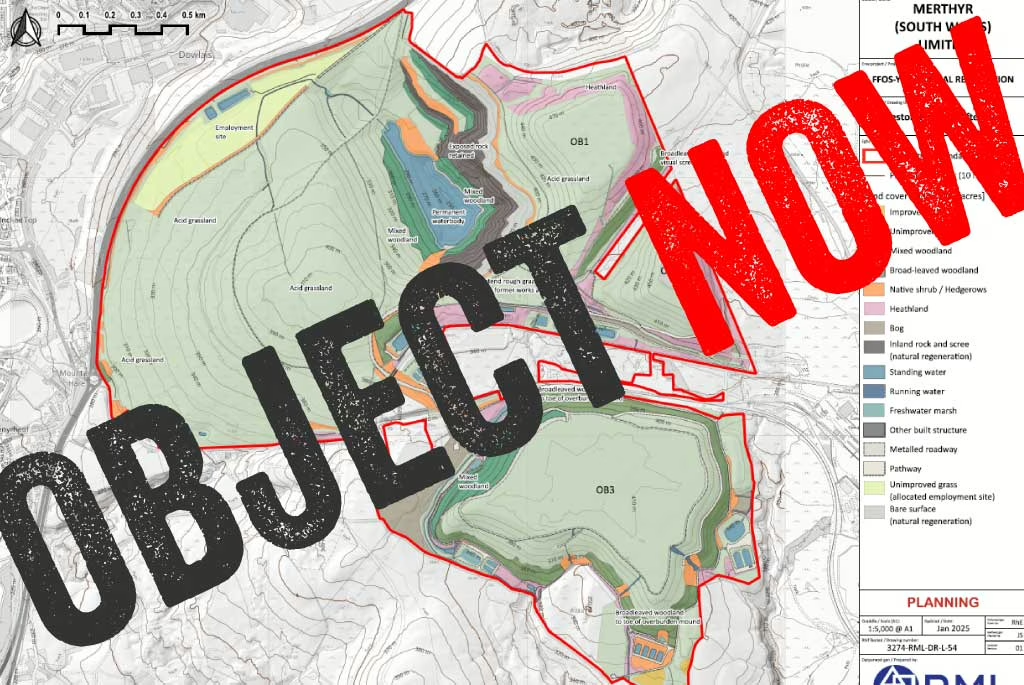
Demand nature be restored to Ffos-y-fran opencast site
January 9th 2026
Merthyr (South Wales) Ltd mined for over a year illegally after planning permission for the Ffos-y-fran opencast coal mine ended in September 2022. During that year, it made record-breaking profits due to sanctions on Russia and other factors driving up the price of coal. But rather than using some of the profits from that ill-gotten coal…

2026 must be the year that new coal extraction will be banned
December 3rd 2025
In November 2024, the new UK Government announced its intention to legislate a ban of new coal mining licences – which we welcomed. Over a year later, the legislation is yet to be introduced, and the Government is not planning to include all types of extraction…

Where our coal comes from
November 21st 2025
The UK steel and cement sectors (and to a lesser extent, bricks) are the largest users of coal following the closing down of the UK’s last coal-fired power station in September 2024. Check out our coal dashboard for our most recent coal stats including an industry break-down. We support the UK Government’s commitment to ban…

A stainless future for steel
November 12th 2025
The steel industry produces 9-11% of the annual CO2 emitted globally, contributing significantly to climate change. In 2024, on average, every tonne of steel produced led to the emission of 2.2 tonnes of CO2e (scope 1, 2, and 3). Globally in 2024, 1,886 million tonnes (Mt) of steel were produced, emitting…

Westminster Hall debate – Coal tip safety & the coal licence ban
November 6th 2025
Last month we worked with Members of Parliament from various parties on a Westminster Hall debate about coal tip safety and the prohibition of new coal extraction licences. The debate happened 59 years and one day after the Aberfan tragedy which killed 116 children and 28 adults…

Concrete opportunities for coal-free cement works
October 29th 2025
Successful, at-scale, examples already exist of cement works burning 100% fuel alternatives to traditional fossil fuels, including pilot projects using combinations of hydrogen and biomass (UK) and hydrogen and electricity (Sweden). Yet, innovations such as use of hydrogen and kiln electrification are…

Caerphilly candidates views on Bedwas coal tips
October 9th 2025
Within the borders of the Senedd Caerphilly constituency is the proposed Bedwas coal tips re-mining project. In the lead up to the Senedd by-election, Coal Action Network has carried out a survey of the by-election candidates asking for their views about the re-mining of the Bedwas and other…

Glan Lash opencast “off-set” exposed
September 16th 2025
In 2019, Bryn Bach Coal Ltd applied to expand its Glan Lash opencast coal mine and extend the amount of time it would continue mining coal for. The proposal would see the coal mine swallowing a nearby ancient woodland, hedgerows, and grassland. The proposal was rejected by Carmarthenshire County Council in 2023…

New advice shows Government how coal prohibition can prevent all new coal prospecting
August 20th 2025
In November 2024, the UK Government announced its commitment to legislating a ban of new coal mining licences. This was a commitment that Coal Action Network had secured a manifesto commitment from the Government for, along with four other major parties…










